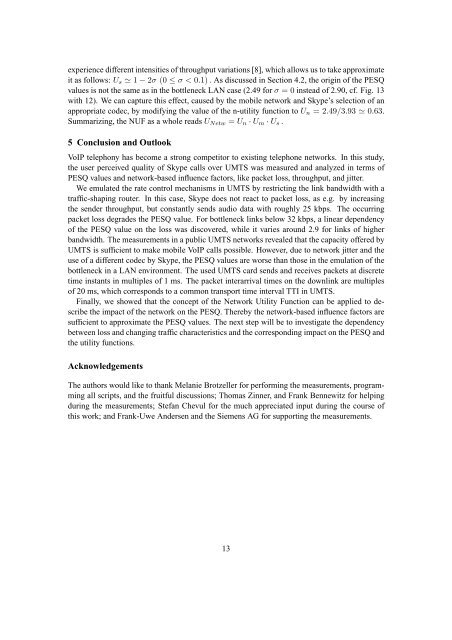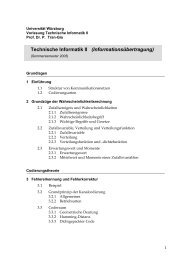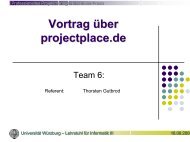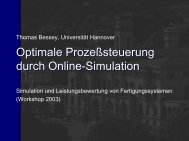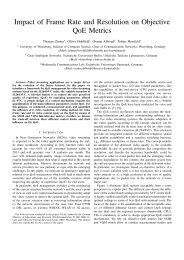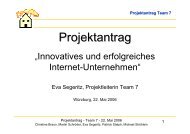Measurement and Analysis of Skype VoIP Traffic in 3G UMTS Systems
Measurement and Analysis of Skype VoIP Traffic in 3G UMTS Systems
Measurement and Analysis of Skype VoIP Traffic in 3G UMTS Systems
You also want an ePaper? Increase the reach of your titles
YUMPU automatically turns print PDFs into web optimized ePapers that Google loves.
experience different <strong>in</strong>tensities <strong>of</strong> throughput variations [8], which allows us to take approximateit as follows: U s ≃ 1 − 2σ (0 ≤ σ < 0.1). As discussed <strong>in</strong> Section 4.2, the orig<strong>in</strong> <strong>of</strong> the PESQvalues is not the same as <strong>in</strong> the bottleneck LAN case (2.49 for σ = 0 <strong>in</strong>stead <strong>of</strong> 2.90, cf. Fig. 13with 12). We can capture this effect, caused by the mobile network <strong>and</strong> <strong>Skype</strong>’s selection <strong>of</strong> anappropriate codec, by modify<strong>in</strong>g the value <strong>of</strong> the n-utility function to U n = 2.49/3.93 ≃ 0.63.Summariz<strong>in</strong>g, the NUF as a whole reads U Netw = U n · U m · U s .5 Conclusion <strong>and</strong> Outlook<strong>VoIP</strong> telephony has become a strong competitor to exist<strong>in</strong>g telephone networks. In this study,the user perceived quality <strong>of</strong> <strong>Skype</strong> calls over <strong>UMTS</strong> was measured <strong>and</strong> analyzed <strong>in</strong> terms <strong>of</strong>PESQ values <strong>and</strong> network-based <strong>in</strong>fluence factors, like packet loss, throughput, <strong>and</strong> jitter.We emulated the rate control mechanisms <strong>in</strong> <strong>UMTS</strong> by restrict<strong>in</strong>g the l<strong>in</strong>k b<strong>and</strong>width with atraffic-shap<strong>in</strong>g router. In this case, <strong>Skype</strong> does not react to packet loss, as e.g. by <strong>in</strong>creas<strong>in</strong>gthe sender throughput, but constantly sends audio data with roughly 25 kbps. The occurr<strong>in</strong>gpacket loss degrades the PESQ value. For bottleneck l<strong>in</strong>ks below 32 kbps, a l<strong>in</strong>ear dependency<strong>of</strong> the PESQ value on the loss was discovered, while it varies around 2.9 for l<strong>in</strong>ks <strong>of</strong> higherb<strong>and</strong>width. The measurements <strong>in</strong> a public <strong>UMTS</strong> networks revealed that the capacity <strong>of</strong>fered by<strong>UMTS</strong> is sufficient to make mobile <strong>VoIP</strong> calls possible. However, due to network jitter <strong>and</strong> theuse <strong>of</strong> a different codec by <strong>Skype</strong>, the PESQ values are worse than those <strong>in</strong> the emulation <strong>of</strong> thebottleneck <strong>in</strong> a LAN environment. The used <strong>UMTS</strong> card sends <strong>and</strong> receives packets at discretetime <strong>in</strong>stants <strong>in</strong> multiples <strong>of</strong> 1 ms. The packet <strong>in</strong>terarrival times on the downl<strong>in</strong>k are multiples<strong>of</strong> 20 ms, which corresponds to a common transport time <strong>in</strong>terval TTI <strong>in</strong> <strong>UMTS</strong>.F<strong>in</strong>ally, we showed that the concept <strong>of</strong> the Network Utility Function can be applied to describethe impact <strong>of</strong> the network on the PESQ. Thereby the network-based <strong>in</strong>fluence factors aresufficient to approximate the PESQ values. The next step will be to <strong>in</strong>vestigate the dependencybetween loss <strong>and</strong> chang<strong>in</strong>g traffic characteristics <strong>and</strong> the correspond<strong>in</strong>g impact on the PESQ <strong>and</strong>the utility functions.AcknowledgementsThe authors would like to thank Melanie Brotzeller for perform<strong>in</strong>g the measurements, programm<strong>in</strong>gall scripts, <strong>and</strong> the fruitful discussions; Thomas Z<strong>in</strong>ner, <strong>and</strong> Frank Bennewitz for help<strong>in</strong>gdur<strong>in</strong>g the measurements; Stefan Chevul for the much appreciated <strong>in</strong>put dur<strong>in</strong>g the course <strong>of</strong>this work; <strong>and</strong> Frank-Uwe Andersen <strong>and</strong> the Siemens AG for support<strong>in</strong>g the measurements.13


